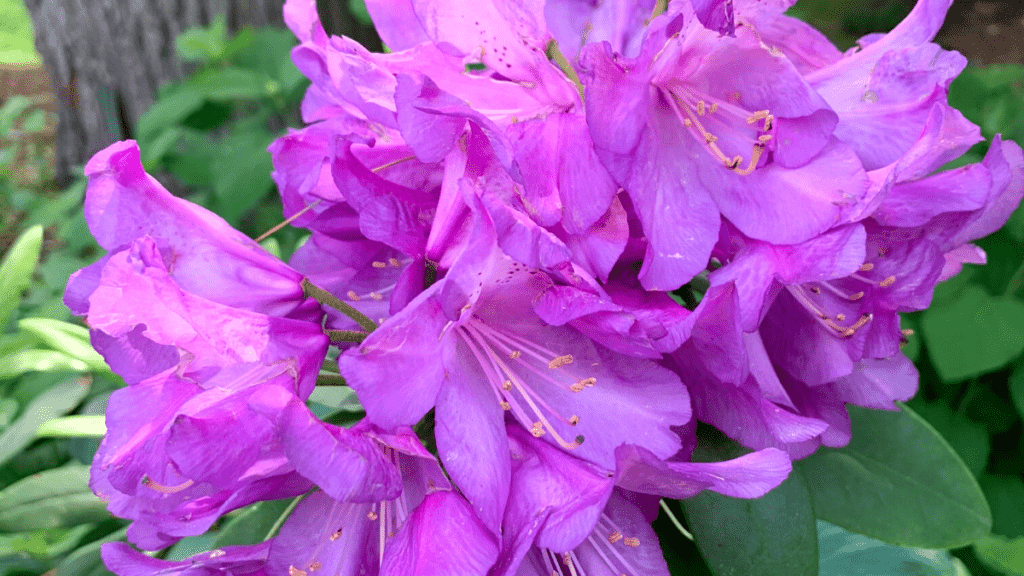How often should you be watering your rhododendrons in the summer? What about Fall and winter, is it even necessary to water rhododendrons in the Fall and Winter?
And what happens when you overwater your Rhododendron?
I have a lot of rhododendrons in my garden, some are newly planted rhododendrons and some are established rhododendrons (they’ve grown taller than me!)
What I love about growing Rhododendrons is that they are such low-maintenance perennial flowering shrubs- so easy to care for!
Plus rhododendrons do well in the shade- it’s become my go-to flowering shrub for shady locations!
Since rhododendrons are so low maintenance, I always wonder how often I should be watering them.
Below are my tips on rhododendron water needs based on my experience caring for the rhododendrons in my garden.

Rhododendron Water Requirements: Summer
If you have well-established rhododendrons in your garden, water them once a week during the summer.
They are more finicky than hydrangeas because Rhododendrons have really shallow root systems making them prone to drying out.
However, if you skip a week or two of watering, it won’t harm your rhododendrons.
I’ve gone on extended summer vacations and no one watered my rhododendrons- they survived! Although you can tell, they do need watering because the leaves are droopy.
If there is a drought, increase the watering frequency to make sure your rhododendron receives enough water.
Don’t forget to spread a layer of mulch around your rhododendrons to help retain moisture during those scorching summer months.

Rhododendron Summer Water Needs: Shady Spot
Now, if your rhododendrons are tucked away in a shady spot beneath some towering trees, things get a bit more challenging.
Those nearby tree roots are competing for water, so you need to pay extra attention.
To ensure your rhododendrons receive their fair share, water them twice a week. Mulching remains your best friend in this situation too.
If there’s a dry spell or a full-blown drought, you should increase the frequency of watering. Just remember to keep the soil moist but not waterlogged. Too much water is never a good thing!
New Planted Rhododendron Summer Water Needs
Let’s talk about newly planted rhododendrons. When I say newly planted rhododendrons, I mean Rhododendrons that were planted in the past 3 years.
These baby rhododendrons need some extra love and care to establish healthy roots.
During the summer, water them three times a week. Even if your rhododendrons have been in the ground for up to three years, treat them as “newly planted” and stick to the three-times-a-week watering routine.
Those shallow roots crave hydration, so aim for a deep soak rather than quick, shallow watering sessions.
If your newly planted rhododendrons happen to be under the shade of trees, it’s crucial to closely monitor their water needs.
Check for signs of wilting and ensure they look healthy. If they seem thirsty, don’t waste any time—give them a good watering right away.
Consider watering them for a few consecutive days to help them bounce back.

How to Water Rhododendrons in the Summer
When it comes to watering your rhododendrons in the summer, focus on deep watering rather than light and frequent spritzes.
This encourages the roots to grow deep and strong, avoiding shallow root development.
Oh, and remember to maintain moist, well-drained soil. We definitely don’t want our rhododendrons sitting in soggy soil, as that can lead to root rot.
Now, what’s the ideal time to water your rhododendron? Well, if possible, go for morning watering.
This way, your rhododendron can absorb the water before the scorching heat settles in. But if mornings just don’t fit into your schedule, late afternoon works just fine.
Keep an eye out for signs that your rhododendrons need supplemental watering during the warm summer months. If you experience a dry spell or drought for a few weeks, it’s time to give them a good drink.

And if your rhododendrons start to look a little wilted, that’s a clear signal that they need water ASAP. In such cases, watering them for a few consecutive days can help revive them.
Rhododendron Water Requirements: Fall
In the fall, as temperatures cool down, rhododendrons enter a period of dormancy. During this time, their watering requirements change.
It’s important to reduce the frequency of watering, allowing the soil to dry out slightly between waterings. This helps maintain a balance between underwatering and overwatering.
I live in Connecticut and I typically don’t water my rhododendron in the Fall, I find the cooler temperature, their shaded location, the mulch, and the occasional rain enough to keep my rhododendrons happy.
I rarely have to supplement with additional watering.

Of course, if I see my rhododendron looking wilted, then I water it.
If you live in a warmer climate, you probably need to water your rhododendrons in the Fall. The best way to gauge rhododendron watering needs is to check the moisture level of the soil by inserting your finger about an inch deep.
If the soil feels dry, it’s time to water. However, if the soil feels moist, hold off on watering until it dries out a bit.
Take into account the rainfall in your area during the fall. If it rained a lot, then you don’t need to water as frequently.
Use your judgment and feel the soil. If you are unsure, it’s better not to water your rhododendrons.
Rhododendron Water Requirements: Winter
Moving on to winter watering, rhododendrons require minimal water during the winter months, especially in regions where the ground freezes.
In Connecticut, I never water my rhododendrons in the winter whether they are established or newly planted.
I find it unnecessary to water rhododendrons in the winter, especially when the ground is frozen!
However, if you live in a warmer climate where the ground never freezes. You should just occasionally feel the soil to see if it’s dry and if your rhododendron looks droopy- that is a sure sign that you need to water it.
I’d err on the side of less watering than overwatering because you don’t want root rot.
If there are extended periods of dryness or if your rhododendrons are exposed to drying winds, occasional supplemental watering may be necessary.
However, ensure that the soil has good drainage to prevent waterlogging.
What Happens to Overwatered Rhododendrons?
Now, let’s discuss the consequences of overwatering rhododendrons. Rhododendrons have shallow root systems, making them vulnerable to root rot when it sits in wet, soggy soil.
Don’t overwater your rhododendrons! Overwatering can cause root rot and yellowing leaves. Surprisingly, overwatering can also cause wilting.
When the roots are constantly saturated, they struggle to absorb oxygen, resulting in wilting.
From personal experience, it’s best to underwater than to overwater your rhododendrons!
Especially if you have established rhododendrons in your garden. In fact, you can get away without watering it all year (of course I don’t recommend it but you technically can neglect your established rhododendrons all year and it will survive!)
Get Your FREE Perennial Plant Care Tracker Printable

Sign up once and you will get access to ALL exclusive content on this website. After unlocking the printable, just save the printable image and then print it. Use it to track your perennial plant care! I hope you like it!

